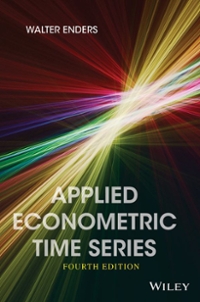Question
8. Using regression adjustments to estimate the effects of policy intervention Suppose you want to examine the effects of a job training program, and estimate
8. Using regression adjustments to estimate the effects of policy intervention
Suppose you want to examine the effects of a job training program, and estimate the following regression model to do so:
earn98=5+2.8train+0.36earn96+0.37educ0.13age+2.7marriedearn98^=5+2.8train+0.36earn96+0.37educ0.13age+2.7married
where
| earn98earn98 = labor market earnings in 1998, in thousands of dollars | |
| traintrain =1 if the employee participated in the training program, and =0 otherwise | |
| earn96earn96 = labor market earnings in 1996 (the year before the training program), in thousands of dollars | |
| educeduc = years of schooling | |
| ageage = age, in years | |
| marriedmarried =1 if the employee is married, and =0 otherwise | |
| nn = 1,080 | |
| R2R2 = 0.45 |
Using unrestricted regression adjustment, which of the following best represents the estimated equation with full interactions?
earn98=5+3.1train+0.38earn96+0.4educ0.16age+3.3married+0.11train(earn96earn96)+0.031train(educeduc)+0.055train(ageage)+1.05train(marriedmarried)earn98^=5+3.1train+0.38earn96+0.4educ0.16age+3.3married+0.11trainearn96earn96+0.031traineduceduc+0.055trainageage+1.05trainmarriedmarried
earn98=5+3.1train+0.38earn96+0.4educ0.16age+3.3married+0.11earn96(traintrain)+0.031educ(traintrain)+0.055age(traintrain)+1.05married(traintrain)earn98^=5+3.1train+0.38earn96+0.4educ0.16age+3.3married+0.11earn96traintrain+0.031eductraintrain+0.055agetraintrain+1.05marriedtraintrain
earn98=5+3.1train+0.38earn96+0.4educ0.16age+3.3married+0.11train(earn96earn96)+0.031train(earn96earn96)+0.055train(earn96earn96)+1.05train(earn96earn96)earn98^=5+3.1train+0.38earn96+0.4educ0.16age+3.3married+0.11trainearn96earn96+0.031trainearn96earn96+0.055trainearn96earn96+1.05trainearn96earn96
earn98=5+3.1train+0.38earn96+0.4educ0.16age+3.3married+0.11train(educeduc)+0.031train(educeduc)+0.055train(educeduc)+1.05train(educeduc)earn98^=5+3.1train+0.38earn96+0.4educ0.16age+3.3married+0.11traineduceduc+0.031traineduceduc+0.055traineduceduc+1.05traineduceduc
Using your answer from the preceding question, the estimated average treatment effect of the training program is uraura^ =
.
Which of the following best represents the meaning of the estimated average effect of the training program?
The training program led to an increase in 1998 earnings of $400.
The training program led to an increase in 1998 earnings of $160.
The training program led to an increase in 1998 earnings of $110.
The training program led to an increase in 1998 earnings of $3,100.
8. Using regression adjustments to estimate the effects of policy intervention
Suppose you want to examine the effects of a job training program, and estimate the following regression model to do so:
earn98=5+2.8train+0.36earn96+0.37educ0.13age+2.7marriedearn98^=5+2.8train+0.36earn96+0.37educ0.13age+2.7married
where
| earn98earn98 = labor market earnings in 1998, in thousands of dollars | |
| traintrain =1 if the employee participated in the training program, and =0 otherwise | |
| earn96earn96 = labor market earnings in 1996 (the year before the training program), in thousands of dollars | |
| educeduc = years of schooling | |
| ageage = age, in years | |
| marriedmarried =1 if the employee is married, and =0 otherwise | |
| nn = 1,080 | |
| R2R2 = 0.45 |
Using unrestricted regression adjustment, which of the following best represents the estimated equation with full interactions?
earn98=5+3.1train+0.38earn96+0.4educ0.16age+3.3married+0.11train(earn96earn96)+0.031train(educeduc)+0.055train(ageage)+1.05train(marriedmarried)earn98^=5+3.1train+0.38earn96+0.4educ0.16age+3.3married+0.11trainearn96earn96+0.031traineduceduc+0.055trainageage+1.05trainmarriedmarried
earn98=5+3.1train+0.38earn96+0.4educ0.16age+3.3married+0.11earn96(traintrain)+0.031educ(traintrain)+0.055age(traintrain)+1.05married(traintrain)earn98^=5+3.1train+0.38earn96+0.4educ0.16age+3.3married+0.11earn96traintrain+0.031eductraintrain+0.055agetraintrain+1.05marriedtraintrain
earn98=5+3.1train+0.38earn96+0.4educ0.16age+3.3married+0.11train(earn96earn96)+0.031train(earn96earn96)+0.055train(earn96earn96)+1.05train(earn96earn96)earn98^=5+3.1train+0.38earn96+0.4educ0.16age+3.3married+0.11trainearn96earn96+0.031trainearn96earn96+0.055trainearn96earn96+1.05trainearn96earn96
earn98=5+3.1train+0.38earn96+0.4educ0.16age+3.3married+0.11train(educeduc)+0.031train(educeduc)+0.055train(educeduc)+1.05train(educeduc)earn98^=5+3.1train+0.38earn96+0.4educ0.16age+3.3married+0.11traineduceduc+0.031traineduceduc+0.055traineduceduc+1.05traineduceduc
Using your answer from the preceding question, the estimated average treatment effect of the training program is uraura^ =
.
Which of the following best represents the meaning of the estimated average effect of the training program?
The training program led to an increase in 1998 earnings of $400.
The training program led to an increase in 1998 earnings of $160.
The training program led to an increase in 1998 earnings of $110.
The training program led to an increase in 1998 earnings of $3,100.
Step by Step Solution
There are 3 Steps involved in it
Step: 1

Get Instant Access to Expert-Tailored Solutions
See step-by-step solutions with expert insights and AI powered tools for academic success
Step: 2

Step: 3

Ace Your Homework with AI
Get the answers you need in no time with our AI-driven, step-by-step assistance
Get Started


